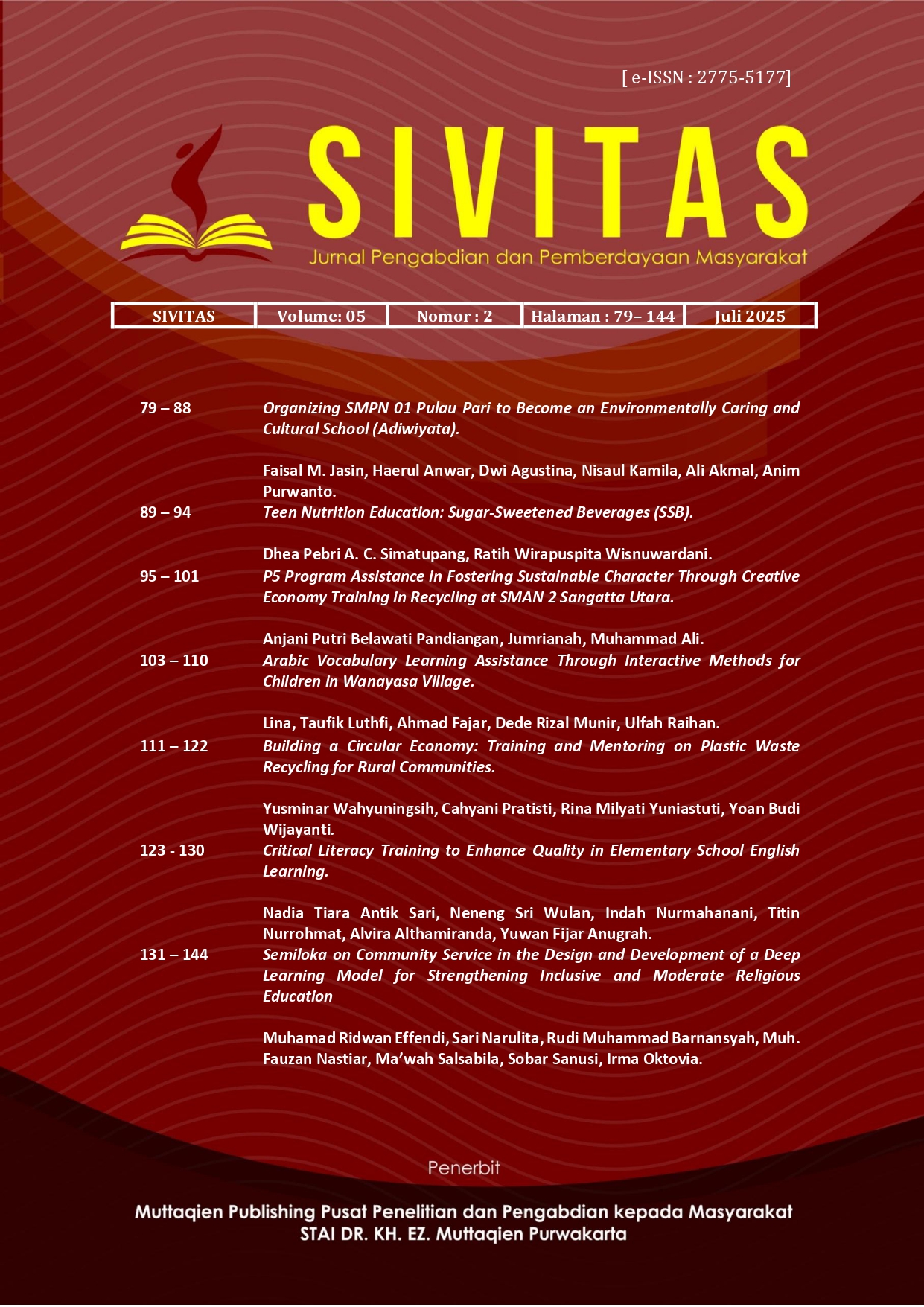Critical Literacy Training to Improve the Quality of English Language Learning at the Elementary School Level
Keywords:
Teacher's Role, Critical Literacy, Reading AnalysisAbstract
Critical Literacy is an educational approach that encourages individuals, especially children, to analyze and question texts and their contexts. This method is vital for helping children critically assess information and avoid misinformation in today’s digital age. This community service project aims to raise awareness about the importance of critical literacy among elementary school students through an interactive webinar involving teachers and students. Preliminary results indicate an increase in both teacher and student engagement, fostering critical thinking skills from an early age. This initiative positively impacts students’ critical literacy abilities, equipping them to tackle future informational challenges effectively.
References
Brownell, C. J. & Rashid, A. (2020). Building Bridges Instead of Walls: Engaging Young Children in Critical Literacy Read Alouds. Journal of Curriculum Studies Research, 2(1), 76-94.
Cynthia, R. E. & Sihotang, H. (2023). Melangkah Bersama di Era Digital: Pentingnya Literasi Digital untuk Meningkatkan Kemampuan Berpikir Kritis dan Kemampuan Pemecahan Masalah Peserta Didik. Jurnal Pendidikan Tambusai, 7(3), 31712–31723.
Emilia, E. (2005). A critical genre based approach to teaching academic writing in a tertiary EFL context in Indonesia, PhD thesis, Dept of Language, Literacy and Arts Education, University of Melbourne.
Gustine, Gin Gin (2014). Critical literacy in an Indonesian EFL setting: sustaining professional learning. Deakin University. Thesis.
Gustine, G. G. (2018). A survey on critical literacy as a pedagogical approach to teaching English in Indonesia. Indonesian Journal of Applied Linguistics, 7(3), 531-537.
Handayani, F. (2020). Membangun Keterampilan Berpikir Kritis Siswa Melalui Literasi Digital Berbasis STEM pada Masa Pandemik Covid 19. Jurnal Cendekiawan, 2(2), 69–72.
Harsiati, T. (2018). Karakteristik Soal Literasi Membaca pada Program PISA. Jurnal Litera, 17(1), 90-106.
Kemendikbud. (2023). Peringkat Indonesia pada PISA 2022 Naik 5-6 Posisi Dibanding 2018. Retrieved November 20, 2024, from: https://www.kemdikbud.go.id/main/blog/2023/12/peringkat-indonesia-pada-pisa-2022-naik-56-posisi-dibanding-2018.
Kurniawati, N., Sugaryamah, D., & Hasanah, A. (2020). Proposing a Model of Critical Literacy Program for Fostering Indonesian EFL Students’ Critical Thinking Skills. Journal of Education and Learning (EduLearn), 14(2), 234–247.
Leiliyanti, E., Irawan, I. N., & Saputra, Z. (2021). Pelatihan Membaca Kritis/Literasi Kritis Teks Naratif Bagi Guru SMP Pendidik Penggerak Indonesia Jaya. Jurnal Masyarakat Mandiri, 5(1), 81-95.
Norris, K.. Lucas, L. & Prudhoe, C. (2012). Examining critical literacy: Preparing preservice teachers to use critical literacy in the early childhood classroom. 19. 59-62.
Pandya, J. Z., Mora, R. A., Alford, J. H., Golden, N. A., & Roock, R. S.. (2022). The Handbook of Critical Literacies. New York: Routledge.
Putri, A. A, et. al. (2023). Pelatihan Membaca Kritis Dengan Media Pembelajaran Cerpen Critical Reading Training Using Short Story Learning Media. Jurnal Nusantara Berbakti, 1(04), 176-184.
Richards J. C. (2008). Growing Up with TESOL. English Teaching Forum. 1(46), 2-11.
Rini, T. A. (2018). Creating Critical Literacy Skills For Young Learners At Primary School. Proceedings of the 1st International Conference on Early Childhood and Primary Education (ECPE 2018), 244, 230-235.
Sandretto, S., & Klenner, S. R. (2011). Planting seeds: Embedding critical literacy into your classroom programme. Wellington, New Zealand: Nzcer Press.
Vasquez, V. M. (2016). Critical literacy across the K-6 curriculum. Routledge.
Vasquez V. M., Janks, H., & Comber B. (2019). Critical Literacy As A Way Of Being and Doing. Language Arts, 96(5), 300-311.
Published
How to Cite
Issue
Section
Copyright (c) 2025 Nadia Tiara Antik Sari, Neneng Sri Wulan, Indah Nurmahanani, Titin Nurrohmat, Alfira Althamiranda, Yuwan Fijar Anugrah

This work is licensed under a Creative Commons Attribution-ShareAlike 4.0 International License.
SIVITAS: Jurnal Pengabdian dan Pemberdayaan Masyarakat allow the author(s) to hold the copyright without restrictions and allow the author(s) to retain publishing rights without restrictions and authors who publish with this journal agree to the following terms:
In developing strategy and setting priorities, SIVITAS: Jurnal Pengabdian dan Pemberdayaan Masyarakat recognize that free access is better than priced access, libre access is better than free access, and libre under CC-BY-SA or the equivalent is better than libre under more restrictive open licenses. We should achieve what we can when we can. We should not delay achieving free in order to achieve libre, and we should not stop with free when we can achieve libre.
SIVITAS: Jurnal Pengabdian dan Pemberdayaan Masyarakat has a CC-BY SA license or its equivalent as the optimal license for publication, distribution, use and reuse of scientific work. This license is under a Creative Commons Attribution 4.0 International License.
You are free to:
- Share — copy and redistribute the material in any medium or format
- Adapt — remix, transform, and build upon the material for any purpose, even commercially.
- The licensor cannot revoke these freedoms as long as you follow the license terms.











